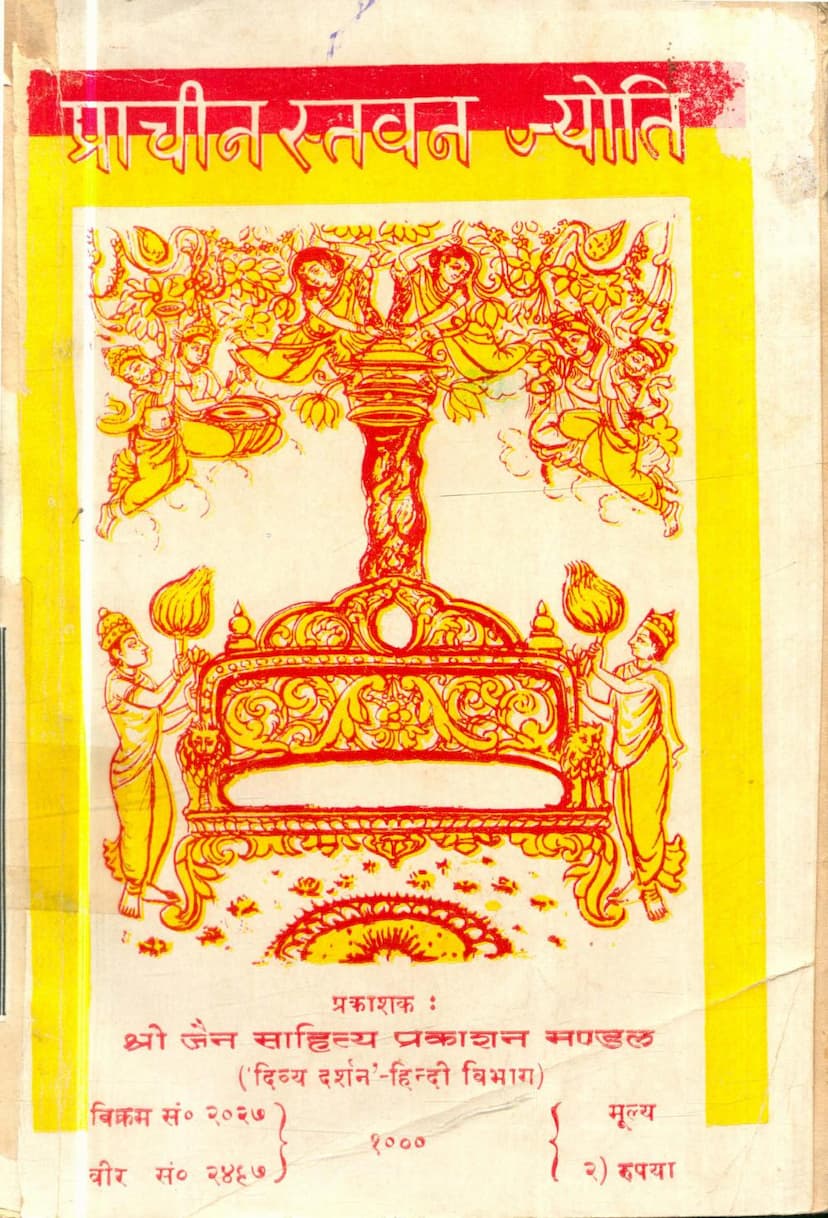Prachin Stavan Jyoti
Added to library: September 2, 2025

Summary
This document is a Jain text titled "Prachin Stavan Jyoti" (Ancient Devotional Songs). Here's a comprehensive summary of its content based on the provided pages:
Overall Purpose and Theme:
The book is a collection of devotional songs (stavan) primarily focused on praising and connecting with the Jain Tirthankaras (enlightened beings). The central theme is the power of devotion (Bhakti) as a means to achieve liberation (Mukti). It emphasizes that through sincere devotion, one can overcome worldly attachments and the cycle of birth and death.
Key Sections and Content:
-
Introduction (Prastavana): The preface eloquently explains how devotion acts as a messenger of liberation. It likens liberation to a beautiful princess who sends her trustworthy messenger, Paramatma Bhakti (devotion to the Supreme Soul), to the soul. If this messenger is pleased and developed through acts of worship (dravya bhakti) and chanting the virtues of the Lord (bhava bhakti), it paves the way for the soul to unite with the liberated state. The importance of selfless offering of valuable materials (keshar, sandalwood, incense, lamps, etc.) and focusing on the Supreme Soul as the ultimate recipient is highlighted. It asserts that devotion makes material possessions less valuable and leads to detachment from wealth.
-
Stavan Collections: The majority of the book is dedicated to a vast collection of stavan, organized by the Tirthankaras.
- Tirthankara-wise Stavan: The book systematically lists stavan dedicated to each of the 24 Tirthankaras, starting from Lord Adinath (Rishabhdev) and progressing through the lineage.
- Individual Stavan Titles: For each Tirthankara, a list of individual stavan titles is provided, often with short introductory verses or themes indicated. For example, under Lord Adinath, there are stavan about his glory, his mother Marudev, and his divine attributes.
- Specific Devotional Themes: Many stavan seem to focus on specific aspects of the Tirthankaras, such as their divine beauty, compassionate nature, teachings, miraculous powers, and the profound love and devotion they inspire in their followers.
- Variety of Moods: The stavan likely encompass a range of emotions, from deep longing and supplication to joyful celebration and philosophical contemplation.
-
Stuti Department: There's a section dedicated to "Stuti" (praises or hymns), which appear to be more formal or structured forms of praise. This includes stutis for:
- Chaitvavandan (veneration of shrines/idols) for various Tirthankaras.
- Specific events like Janm Kalyanak (birth anniversary).
- The "Beej Ka Stavan" (Root Devotional Song), "Gyanpanchmi Ka Stavan" (Devotional Song for Gyan Panchami), and "Navpadji Ka Stavan" (Devotional Song for Navpadji).
-
Snatra Puja: A significant portion of the book details the ritual of "Snatra Puja" (Abhisheka Puja), which involves the ceremonial bathing and anointing of the idol of a Tirthankara.
- Detailed Rituals: The text provides verses and instructions for various aspects of the puja, including offering flowers (kusumjali), applying sandalwood, chanting mantras, and performing the Abhishek with different substances.
- Illustrative Verses: The verses describe the divine grandeur of the Tirthankaras and the devotion of celestial beings (devas) participating in the ritual.
- Specific Tirthankara Pujas: There are sections detailing Snatra Puja specifically for Lord Parshvanath and Lord Mahavir, and general pujas for other Tirthankaras.
- Compilation of Pujas: The Snatra Puja section includes contributions from respected Jain scholars like Pandit Shri Virvijayji Maharaj and Shri Devchandji, indicating the authoritative nature of these rituals.
-
Eight-Part Puja (Ashtaprakari Puja): The book also outlines the Ashtaprakari Puja, a common Jain ritual involving offerings of water, sandalwood, flowers, incense, lamp, unbroken rice (akshat), food (naivedya), and fruit (phal) to the Tirthankaras. Each offering is accompanied by specific verses.
-
Chaitvavandan Department: This section contains more detailed stavan and prayers for venerating the idols of various Tirthankaras, often including biographical details like their lineage, lifespan, and symbolic emblems.
-
Stavan Department (Detailed): This is the core of the book, featuring numerous stavan with their titles and lyrics. The content of these stavan varies, covering:
- Praise of Tirthankaras: Praising their divine attributes, beauty, and teachings.
- Personal Devotion: Expressing the devotee's love, longing, and desire for connection.
- Philosophical Themes: Discussing detachment, karma, and the path to liberation.
- Narrative Stavan: Recounting stories or events related to the Tirthankaras.
-
Illustrations and Visuals: The presence of images suggests that the book might be visually rich, potentially including depictions of Tirthankara idols, temple scenes, and rituals.
Key Concepts Highlighted:
- Bhakti (Devotion): The central pillar of the text, emphasized as the path to spiritual progress and liberation.
- Mukti (Liberation): The ultimate goal, achievable through devotion and spiritual practice.
- Dravya Bhakti: Devotion through material offerings and rituals.
- Bhava Bhakti: Devotion through internal feelings, chanting, and contemplation of virtues.
- Paramatma (Supreme Soul): The object of ultimate devotion.
- Tirthankara: The 24 enlightened beings who guide humanity towards liberation.
- Karma: The cycle of actions and their consequences that binds the soul.
- Detachment (Vairagya): Overcoming worldly desires and attachments.
- Spiritual Practice: Engaging in rituals, chanting, and contemplation.
Publisher and Origin:
The book is published by "Shri Jain Sahitya Prakashan Mandal" under the "Divya Darshan" Hindi department. It was published in Vikram Samvat 2027 and Veer Samvat 2467. The publisher has offices in Jaipur, Ahmedabad, and Mumbai, indicating a wide reach.
In essence, "Prachin Stavan Jyoti" is a comprehensive compilation of Jain devotional literature, offering a rich resource for spiritual practice, cultural heritage, and philosophical understanding within the Jain tradition. It serves as a guide for devotees to connect with the Tirthankaras through song, prayer, and ritual, ultimately aiming for spiritual purification and liberation.